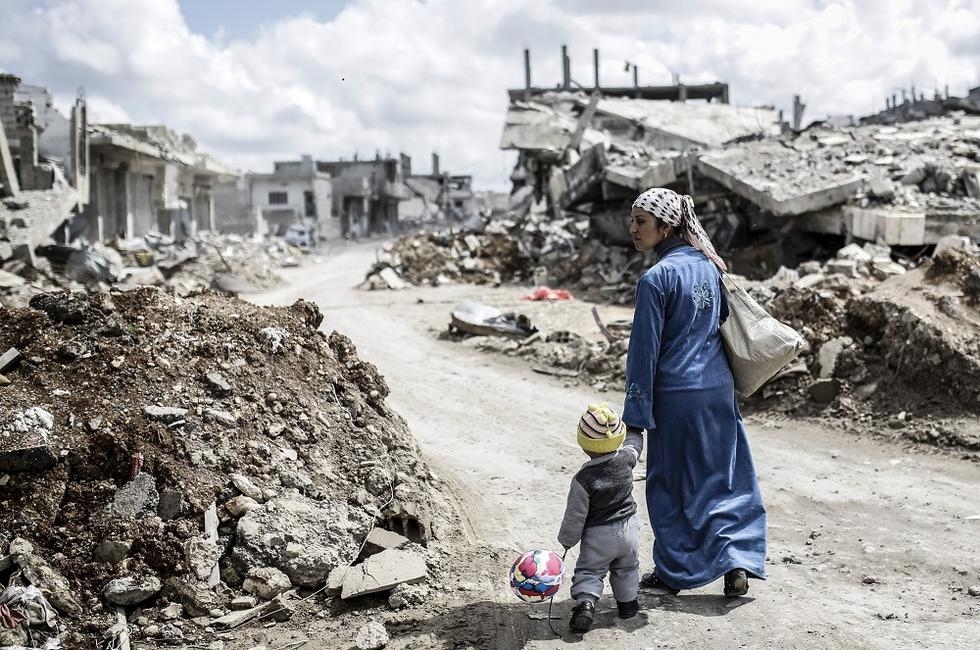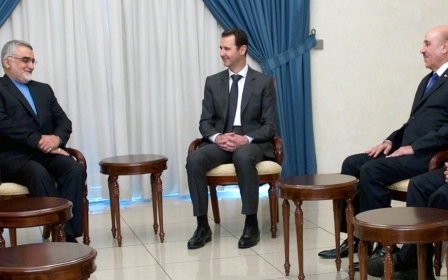ANALYSIS: Third time lucky for Syria talks?

By Imogen Foulkes
Those involved describe them as “under the radar”, and indeed, many people may not have even noticed that in Geneva this month a third round of negotiations on the Syrian conflict is underway.
It is the latest attempt to try to bring some calm to a war that is now in its fifth year, has claimed at least 220,000 lives, driven more than nine million people from their homes, and seen the rise of a new terror group, the so-called Islamic State (IS).
This briefing looks at progress to date and the challenges ahead.
What’s been done so far to bring peace?
The United States and its allies regarded Syria’s “Arab Spring”, and the response to it by President Bashar al-Assad’s forces, as a clear sign that change was necessary: “Assad has to go” was the phrase repeated at every opportunity by senior state department officials.
Russia, traditionally more supportive of Assad, did not sign up to that view, saying instead that a decision on a new government would have to be made by the Syrian people. Deadlock at the UN Security Council ensued, despite a series of horrific reports from the UN’s own commission of inquiry on Syria, which documented widespread evidence of very serious violations, including war crimes and crimes against humanity.
Geneva One
Former UN secretary-general Kofi Annan was the first to take up the difficult post of special envoy for Syria. At the end of June 2012 he brought the world’s top diplomats to Geneva in a bid to broker, if not a peace deal, at least a ceasefire, and some form of agreement on a way forward for Syria.
The hope was that the more tranquil surroundings of Geneva would facilitate understanding among those who had failed to agree in the tense atmosphere of the UN Security Council in New York. Key regional players were also invited, among them Iraq, Turkey, and the Arab League. Not present, or at least not officially, were any representatives of the Syrian government or the opposition.
Geneva One did come up with something: a communiqué laying out a six-point plan, which included a call for an immediate end to violence, and a set of principles and guidelines to start a political transition. The end goal was a government that would “meet the legitimate aspirations of the Syrian people”.
The language of the communiqué was deliberately vague on the subject of Assad’s future role in any transitional government, leaving the US to continue to suggest he would not play a part, and Russia to say he might if the Syrian people wished it.
Although the first item on that six-point plan called for an end to violence, the summer of 2012 instead saw violence escalate, with more and more evidence of the most serious human rights violations.
That July, the International Committee of the Red Cross (ICRC) announced that the conflict in Syria was now so widespread that it constituted a civil war. And a few weeks later, former UN chief and UN’s Syria envoy Kofi Annan resigned. One of the world’s most experienced peacemakers had clearly signalled that the Syria problem was intractable.
Then what happened?
The war went on, and on. In March 2013 the number of refugees reached one million and by September, two million. With violence and displacement escalating, and none of Geneva Communique’s six-points implemented, the peace process seemed to be dead, with no new diplomatic options on the table.
Then in August 2013 a chemical weapons attack, believed to be Sarin gas, killed over a thousand people in the Damascus suburb of Ghouta.
The appalling images of suffering, and the use of a banned weapon in clear violation of the rules of war, put military intervention back on the agenda.
US President Barack Obama and British Prime Minister David Cameron both wanted to intervene, but were thwarted domestically. British members of parliament, mindful of what many viewed as a serious mistake in Iraq a decade earlier, rejected Cameron’s proposal. In Washington, Congress began debating military intervention, but then postponed the vote indefinitely.
So what about Geneva Two?
With no military option on the table, thoughts turned again to diplomacy, this time with a new UN envoy, the highly experienced Algerian diplomat Lakhdar Brahimi. Having already held tricky UN jobs in Afghanistan and Iraq, Brahimi was widely regarded for his wisdom and patience. If anyone could get the warring parties to talk, it was suggested, Brahimi was the man.
For months, Brahimi worked towards negotiations. He wanted to bring not just the major international and regional powers to the negotiating table, but also those actually fighting on the ground. A good plan, in theory, but in the long years of Syria’s conflict the opposition had fragmented into many armed groups, some of whom were actually fighting each other as well as Syrian government forces. Deciding who would come to Geneva Two, and who would legitimately represent the opposition, became an enormously tricky diplomatic exercise in itself.
Finally, in January 2014, a guest list was assembled, and representatives began to turn up. So too did hundreds of journalists. The first days of Geneva Two became a tense media circus, with briefings and counter briefings as different sides stepped out of the negotiating rooms in an attempt to convey their messages through the press. In reality, inside those negotiating rooms, not a lot was happening. Despite all the fanfare about meeting face-to-face, the warring parties actually sat, it emerged, around a U-shaped table in a way that meant they could avoid eye contact. All their words were directed through Brahimi; they never actually spoke to each other.
There were disagreements over what should be discussed, with Syrian government representatives trying to prioritise “fighting terrorism”, while UN diplomats tried to stick to the Geneva Communique’s six points.
By now, the opposition was so divided that there were internal disagreements over who would be included in any future transitional government.
Within weeks, and despite another lower-key round in February 2014, Geneva Two was as dead as its predecessor. At the end of May that year Brahimi also resigned. The war continued.
Enter De Mistura
Next came special envoy Staffan de Mistura, a long serving UN diplomat, who was appointed in July 2014. He began his new job very gingerly indeed, rarely speaking to the press, and giving little indication about how he planned to approach his task.
His first big move came in late 2014 when he announced plans for “freeze zones,” which in plain English meant regional, temporary ceasefires. The idea was to make some space to get aid in and hope that peace would grow organically from within. Although the plan received a cautious welcome outside Syria, neither the government in Damascus nor opposition fighters ever really bought into the idea, and it never got off the ground.
Subsequently De Mistura has been criticised, though views of his performance differ: some argue he has tried to talk to too many different groups, others say he gives too much attention to the Syrian government.
Where are we now?
Three months after that freeze plan melted away, new talks are finally underway. Keen to avoid the high profile failure of Geneva Two, De Mistura seems to be taking a “softly, softly” approach. “Low key, low profile, under the radar” is how one UN official described these latest talks, quite a departure from the media frenzy of Geneva Two.
The talks, which are expected to roll on until the end of June, are being termed as “separate consultations” with as many different stakeholders as possible. The UN is insisting they should not be called “peace talks”. Instead, they are individual conversations aimed at trying to identify possible negotiating positions. The UN is also reluctant to use the label “Geneva III”, clearly wishing to avoid comparison with Brahimi and Annan’s flops.
De Mistura has tried hard to be inclusive, inviting as many key players in Syria as possible, from women’s groups, to human rights groups, opposition groups and of course government representatives.
Regional and international powers such as Turkey, Lebanon, Jordan, Egypt, Saudia Arabia, and controversially, Iran, will also attend. Teheran was left off the guest list for Geneva Two, but now that a deal on Iran’s nuclear programme seems to be in sight, attitudes appear to have mellowed.
But, and it’s a big but, two of the key fighting forces in Syria - the group calling itself Islamic State (IS) and Jabhat Al Nusra - are not coming to Geneva.
Anyone who has ever negotiated a peace deal agrees that even those who have committed the worst atrocities will, at some point, have to be involved in ending the fighting.
So what are the chances of success?
To be blunt, not great. De Mistura has admitted this himself. Still, he said last week: “We have to try…the people of Syria cannot be abandoned.” It may be that this slow, quiet approach will work better than the previous higher profile attempts. And some of those attending do believe there is a new sense of urgency about these talks.
“There is a feeling that the window of opportunity may be closing” suggested one western diplomat. Perhaps, the thinking goes, that sense of urgency may encourage traditional UN Security Council foes the US and Russia to work more closely together when it comes to Syria.
The problem is, peace in one part of Syria may not mean peace in another. The conflict is now so fragmented that it is being fought, one diplomat pointed out, not over a country, but over individual towns, villages, and even roads.
All the while, the humanitarian catastrophe continues. Recent history shows that wars, especially civil wars, now tend to end at the negotiating table rather than on the battlefield, and that even the most hardened of belligerents eventually get tired of fighting.
But for the ordinary people of Syria the urgent question is “when?” And what will be left of their country when the guns finally fall silent?
This article originally appeared in IRIN on 14 May, 2015
Middle East Eye propose une couverture et une analyse indépendantes et incomparables du Moyen-Orient, de l’Afrique du Nord et d’autres régions du monde. Pour en savoir plus sur la reprise de ce contenu et les frais qui s’appliquent, veuillez remplir ce formulaire [en anglais]. Pour en savoir plus sur MEE, cliquez ici [en anglais].




